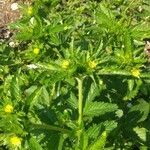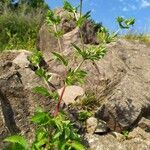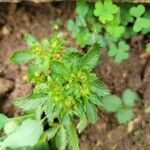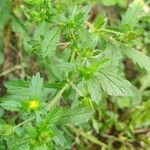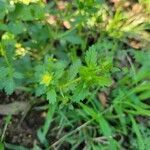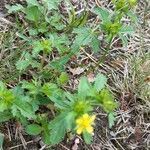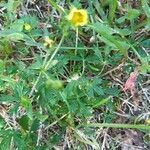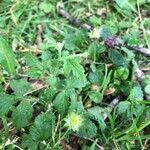Stems ascending to erect, (0.5–)2–5(–9) dm, hairs at base ± stiff, tubercle-based, glands absent or sparse, inconspicuous. Leaves ternate, rarely palmate, 3–15(–20) cm; petiole 1–6(–10) cm, long hairs sparse to abundant, spreading to ascending, 1–2.5(–3) mm, usually ± stiff, ± crisped hairs absent or sparse to common, glands absent or sparse, inconspicuous; leaflets 3(–5), at tip of leaf axis, separate to ± overlapping, largest ones broadly oblanceolate or elliptic to obovate, 1–6(–10) × 0.7–4(–5) cm, distal (1/2–)2/3–3/4+ of margin usually ± evenly incised 1/4–1/3 to midvein, teeth (3–)4–8(–15) per side, surfaces sparsely to moderately hairy, sometimes glabrate or abundantly hairy, glands mostly absent. Inflorescences 5–40+-flowered. Pedicels (0.2–)0.5–2.5(–3) cm. Flowers: epicalyx bractlets ± elliptic to narrowly ovate, (3–)4–8(–13) × 1.5–3(–5) mm; hypanthium 4–7 mm diam.; sepals 5–8 mm, apex acute to obtuse; petals yellow, broadly obovate, (2–)3–5 × 2–4 mm; stamens 15 or 20, filaments 0.7–2 mm, anthers 0.3–0.5 mm; carpels 60–150, styles 0.7–0.8 mm. Achenes tan to brown, 0.8–1.3 mm, usually strongly rugose, without a corky protuberance. 2n = 42, 56, 63, 70.
More
Stout, leafy annual to short-lived perennial, the stem mostly branched and many-fld, hirsute below, subtomentose above; lfls 3, elliptic to broadly obovate, to 8 cm, crenate; fls yellow, nearly 1 cm wide, the pet nearly as long as the sep; bractlets and sep lance-ovate, subequal at anthesis, the sep accrescent in fr and to 15 mm; stamens usually 20; anthers 0.3 mm; achenes flattened, 1 mm, usually marked with curved longitudinal ridges; 2n=42, 56, 70. In a wide variety of habitats; circumboreal, s. in Amer. to S.C., Tenn., Tex., and Calif. June–Aug. The native American plants tend to differ slightly from the European ones, and have been segregated as P. monspeliensis L. or P. norvegica var. hirsuta (Michx.) Torr. & A. Gray, but no clear distinction can be made, and the Eurasian phase has also apparently been intr. into our range.
